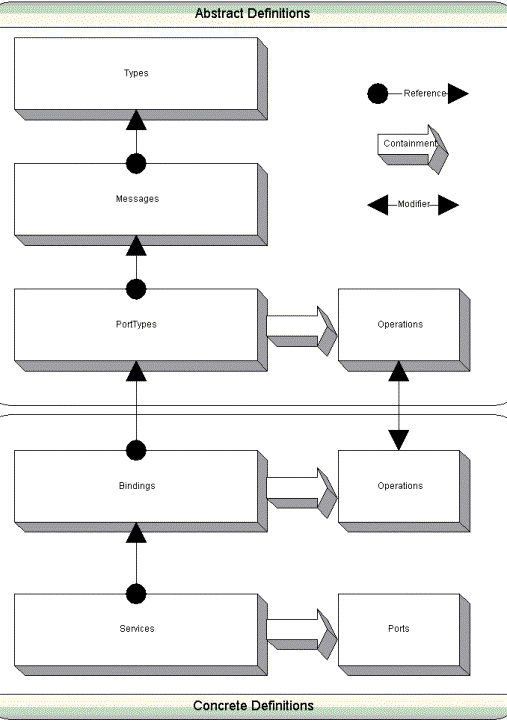- 浏览: 160859 次
- 性别:

- 来自: 奥克兰
-

文章分类
最新评论
-
u012625419:
...
CXF之用spring配置服务端和客户端实例(转) -
bambooshangye:
CXF之用spring配置服务端和客户端实例(转) -
最佳蜗牛:
写的很好,谢谢!
tomcat下的server.xml文件和context.xml (转) -
mohaowen1989:
亲 有中文版的么?在grails基础上的spring-secu ...
Simplified Spring Security with Grails(转) -
douhongyang:
挺好,,思路很清晰,
spring security详解教程 (转)
转自 http://www.blogjava.net/baoyaer/articles/116413.html
WSDL文档可以分为两部分。顶部分由抽象定义组成
,而底部分则由具体描述组成。抽象部分以独立于平台和语言的方式定义SOAP消息,它们并不包含任何随机器或语言而变的元素。这就定义了一系列服务,截然不同的网站都可以实现。随网站而异的东西如序列化便归入底部分,因为它包含具体的定义。
l 抽象定义
Types - 独立与机器和语言的类型定义
Messages - 包括函数参数(输入与输出分开)或文档描述
PortTypes - 引用消息部分中消息定义来描述函数签名(操作名、输入参数、输出参数)
2 具体定义
Bindings
PortTypes - 部分的每一操作在此绑定实现 (one-way|reuqest-response|solicit-response|notification)
Services - 确定每一绑定的端口地址
<definitions> <types> ... </types> <message> ... </message> <portType> ... </portType> <binding> ... </binding> <service> ... </serivce> </definitions>
下面的图中,箭头连接符代表文档不同栏
之间的关系。点和箭头代表了引用或使用关系。双箭头代表"修改"关系。3-D的箭头代表了包含关系。这样,各Messages栏使用Types栏的定
义,PortTypes栏使用Messages栏的定义;Bindings栏引用了PortTypes栏,Services栏引用Bindings
栏,PortTypes和Bindings栏包含了operation元素,而Services栏包含了port元素。PortTypes栏里的
operation元素由Bindings栏里的operation元素进一步修改或描述。
首先看看一段简单的JAVA代码,我们用它作为WSDL的服务实现代码:
public class Test{
public String echo(String u){
return "Hello " + u;
}
}
看看它导出的文件:
第一行申明该文档是XML。尽管这并不是必需的,但它有助于XML解析器决定是否解析 WSDL文件或只是报错。第二行是WSDL文档的根元素:<definitions>。一些属性附属于根元素,就 像<schema>子元素对于<types>元素。
<?xml version="1.0" encoding="UTF-8" ?>
<wsdl:definitions targetNamespace="http://localhost/axis/Test2.jws"
xmlns:wsdl="http://schemas.xmlsoap.org/wsdl/"
xmlns:xsd="http://www.w3.org/2001/XMLSchema"
xmlns:soapenc="http://schemas.xmlsoap.org/soap/encoding/"
xmlns:wsdlsoap="http://schemas.xmlsoap.org/wsdl/soap/"
xmlns:apachesoap="http://xml.apache.org/xml-soap"
xmlns:intf="http://localhost/axis/Test2.jws"
xmlns:impl="http://localhost/axis/Test2.jws">
<!--
WSDL created by Apache Axis version: 1.4
Built on Apr 22, 2006 (06:55:48 PDT)
-->
定义好操作(或方法)以后,现在需要指定将向它们发送和从它们返回的参数。在 WSDL 术语中,所有参数称为“消息”。认为您是在递送消息而结果得到返回的消息是有用的。方法调用是这样一种操作:它准备返回“消息”来响应进入的消息。
<message>元素包含了Messages栏。如果我们把操作看作函数,<message>元素定义了那个
函数的参数。<message>元素中的每个<part>子元素都和某个参数相符。输入参数在<message>元
素中定义,与输出参数相隔离--输出参数有自己的<message>元素。兼作输入、输出的参数在输入输出的<message>
元素中有它们相应的<part>元素。输出<message>元素以"Response"结尾,就像以前所用
的"fooResponse"。每个<part>元素都有名字和类型属性,就像函数的参数有参数名和参数类型。
<wsdl:message name="echoResponse"> //返回的消息 <wsdl:part name="echoReturn" type="xsd:string" /> </wsdl:message> <wsdl:message name="echoRequest"> //请求的消息 <wsdl:part name="u" type="xsd:string" /> </wsdl:message>
<definitions>
元素包含一个或多个 <portType>
元素,实际上,每个元素都是您希望表示的一系列 operation
。或者,您也可以将单个 portType
元素看作是将各种方法组成类的一个逻辑分组。例如,如果您的供应链管理解决方案需要在客户和供应商之间进行交互,您最可能做的是分别定义与他们交互的功能
性;也就是说,您将为用户和供应商各定义一个 portType。应该将每个 portType 称为 服务
,因此整个 WSDL 文件将成为一个服务集合。
<wsdl:portType name="Test2"> //一个portType可以看成一个类
<wsdl:operation name="echo" parameterOrder="u"> //一个operation就是一个方法
<wsdl:input name="echoRequest" message="impl:echoRequest" /> //输入消息
<wsdl:output name="echoResponse" message="impl:echoResponse" /> //返回消息
</wsdl:operation>
</wsdl:portTyp>
消息传递和传输:
我以一种抽象方式定义了操作和消息,而不考虑实现的细节。实际上,WSDL 的任务是定义或描述 Web 服务,然后提供一个对外部框架的引用来定义 WSDL 用户将如何实现这些服务。可以将这个框架当作 WSDL 抽象定义和它们的实现之间的“绑定( binding
)”。
当前,最流行的绑定( binding
)技术是使用简单对象访问协议
(SOAP)。WSDL 将指定能够访问 Web 服务实际实现的 SOAP 服务器,并且从那时起 SOAP 的整个任务就是将用户从 WSDL 文件带到它的实现
。
WSDL 编写的第三个步骤是描述将 SOAP 与 WSDL 文件绑定到一起的过程
您将把 <binding>
元素包括到 <definitions>
元素内。这个 binding 元素应该有 name
和 type
属性。 name
将标识这个绑定而 type
将标识您希望与这个绑定相关联的 portType(一组操作)。
<wsdl:binding name="Test2SoapBinding" type="impl:Test2">...</wsdl:binding>
<wsdlsoap:binding> 元素。该元素的用途是声明将把 SOAP 作为绑定和传输服务使用
<wsdlsoap:binding>
元素有两个属性:style 和
transport
。style 是一个可选属性(rpc|document),它描述该绑定内操作的性质。transport 属性指定 HTTP
作为该绑定将使用的级别较低的传输服务。SOAP 客户机将从 WSDL 文件中读取 SOAP 结构并与另一端的 SOAP 服务器协调.
<wsdlsoap:binding style="rpc" transport="http://schemas.xmlsoap.org/soap/http" />
WSDL <operation>
元素,分别表示具体的操作。每个 <operation>
元素提供各自操作的绑定细节。因此,我提供了另一个 extensibility
元素,即 <wsdlsoap:operation/>
(仍然是一个空元素,与它发生的那个操作相关)。该 <soap:operation/>
元素有一个 soapAction 属性,SOAP 客户机将使用该属性创建 SOAP 请求。
//下面将WSDL描述与具体实现进行绑定,这里采用SOAP方式
<wsdl:binding name="Test2SoapBinding" type="impl:Test2">
<wsdl:operation name="echo">
<wsdlsoap:operation soapAction="" />
<wsdl:input name="echoRequest">
<wsdlsoap:body use="encoded" encodingStyle="http://schemas.xmlsoap.org/soap/encoding/" namespace="http://DefaultNamespace" />
</wsdl:input>
<wsdl:output name="echoResponse">
<wsdlsoap:body use="encoded" encodingStyle="http://schemas.xmlsoap.org/soap/encoding/" namespace="http://localhost/axis/Test2.jws" />
</wsdl:output>
</wsdl:operation>
</wsdl:binding>
//下面将发布的服务与前面的SOAP绑定进行关联
<wsdl:service name="Test2Service">
<wsdl:port name="Test2" binding="impl:Test2SoapBinding">
<wsdlsoap:address location="http://localhost/axis/Test2.jws" />
</wsdl:port>
</wsdl:service>
每个namespace属性都声明了一个缩略语,用在文档中。例如"xmlns:xsd"就为
http://www.w3.org/2001/XMLSchema定义了一个缩略语(xsd)。这就允许对该namespace的引用只需简单的在名字
前加上前缀就可以了,如:"xsd:int"中的"xsd"就是合法的类型名。普通范围规则可运用于缩略前缀。也就是说,前缀所定义的元素只在元素中有
效。
Namespace派什么用?namespace的作用是要避免命名冲突。如果我建立一项Web
Service,其中的WSDL文件包含一个名为"foo"的元素,而你想要使用我的服务与另一项服务连接作为补充,这样的话另一项服务的WSDL文件就
不能包含名为"foo"的元素。两个服务器程序只有在它们在两个事例中表示完全相同的东西时,才可以取相同的名字。如果有了表示区别的
namespace,我的网络服务里的"foo"就可以表示完全不同于另一个网络服务里"foo"的含义。在你的客户端里,你只要加以限制就可以引用我
的"foo"。
见下例:http://www.infotects.com/fooService#foo
就是完全限制的名字,相当于"carlos:foo",如果我声明了carlos作为http://www.infotects.com
/fooService的快捷方式。请注意namespace中的URL是用来确定它们的唯一性的,同时也便于定位。URL所指向的地方不必是实际存在的
网络地址,也可以使用GUID来代替或补充URL。例如,GUID"335DB901-D44A-11D4-A96E-0080AD76435D"就是一
个合法的namespace指派。
targetNamespace属性声明了一个namespace,元素中所有的声明的名字都列于其内。在WSDL示例中,<definitions>的targetNamespace 是http://tempuri.org/wsdl
。这意味着所有在WSDL文档中声明的名字都属于这个namespace。<schema>元素有自己的targetNamespace属性,其值为 http://tempuri.org/xsd
,在<schma>元素中定义的所有名字都属于这个namespace而不是main的target namespace。
<schema>元素的以下这行声明了默认的namespace。Schema中所有有效的名字都属于这个namespace。
附一个比较完整的例子,以供参考学习:
SOAP request
<SOAP-ENV:Envelope
xmlns:SOAP-ENV="http://schemas.xmlsoap.org/soap/envelope/"
SOAP-ENV:encodingStyle="http://schemas.xmlsoap.org/soap/encoding/">
<SOAP-ENV:Body>
<m:GetEndorsingBoarder xmlns:m="http://namespaces.snowboard-info.com">
<manufacturer>K2</manufacturer>
<model>Fatbob</model>
</m:GetEndorsingBoarder>
</SOAP-ENV:Body>
</SOAP-ENV:Envelope>
SOAP response
<SOAP-ENV:Envelope
xmlns:SOAP-ENV="http://schemas.xmlsoap.org/soap/envelope/"
SOAP-ENV:encodingStyle="http://schemas.xmlsoap.org/soap/encoding/">
<SOAP-ENV:Body>
<m:GetEndorsingBoarderResponse xmlns:m="http://namespaces.snowboard-info.com">
<endorsingBoarder>Chris Englesmann</endorsingBoarder>
</m:GetEndorsingBoarderResponse>
</SOAP-ENV:Body>
</SOAP-ENV:Envelope>
WSDL description
<?xml version="1.0"?>
<!-- root element wsdl:definitions defines set of related services -->
<wsdl:definitions name="EndorsementSearch"
targetNamespace="http://namespaces.snowboard-info.com"
xmlns:es="http://www.snowboard-info.com/EndorsementSearch.wsdl"
xmlns:esxsd="http://schemas.snowboard-info.com/EndorsementSearch.xsd"
xmlns:soap="http://schemas.xmlsoap.org/wsdl/soap/"
xmlns:wsdl="http://schemas.xmlsoap.org/wsdl/">
<!-- wsdl:types encapsulates schema definitions of communication types; here using xsd -->
<wsdl:types>
<!-- all type declarations are in a chunk of xsd -->
<xsd:schema targetNamespace="http://namespaces.snowboard-info.com"
xmlns:xsd="http://www.w3.org/1999/XMLSchema">
<!-- xsd definition: GetEndorsingBoarder [manufacturer string, model string] -->
<xsd:element name="GetEndorsingBoarder">
<xsd:complexType>
<xsd:sequence>
<xsd:element name="manufacturer" type="string"/>
<xsd:element name="model" type="string"/>
</xsd:sequence>
</xsd:complexType>
</xsd:element>
<!-- xsd definition: GetEndorsingBoarderResponse [... endorsingBoarder string ...] -->
<xsd:element name="GetEndorsingBoarderResponse">
<xsd:complexType>
<xsd:all>
<xsd:element name="endorsingBoarder" type="string"/>
</xsd:all>
</xsd:complexType>
</xsd:element>
<!-- xsd definition: GetEndorsingBoarderFault [... errorMessage string ...] -->
<xsd:element name="GetEndorsingBoarderFault">
<xsd:complexType>
<xsd:all>
<xsd:element name="errorMessage" type="string"/>
</xsd:all>
</xsd:complexType>
</xsd:element>
</xsd:schema>
</wsdl:types>
<!-- wsdl:message elements describe potential transactions -->
<!-- request GetEndorsingBoarderRequest is of type GetEndorsingBoarder -->
<wsdl:message name="GetEndorsingBoarderRequest">
<wsdl:part name="body" element="esxsd:GetEndorsingBoarder"/>
</wsdl:message>
<!-- response GetEndorsingBoarderResponse is of type GetEndorsingBoarderResponse -->
<wsdl:message name="GetEndorsingBoarderResponse">
<wsdl:part name="body" element="esxsd:GetEndorsingBoarderResponse"/>
</wsdl:message>
<!-- wsdl:portType describes messages in an operation -->
<wsdl:portType name="GetEndorsingBoarderPortType">
<!-- the value of wsdl:operation eludes me -->
<wsdl:operation name="GetEndorsingBoarder">
<wsdl:input message="es:GetEndorsingBoarderRequest"/>
<wsdl:output message="es:GetEndorsingBoarderResponse"/>
<wsdl:fault message="es:GetEndorsingBoarderFault"/>
</wsdl:operation>
</wsdl:portType>
<!-- wsdl:binding states a serialization protocol for this service -->
<wsdl:binding name="EndorsementSearchSoapBinding"
type="es:GetEndorsingBoarderPortType">
<!-- leverage off soap:binding document style @@@(no wsdl:foo pointing at the soap binding) -->
<soap:binding style="document"
transport="http://schemas.xmlsoap.org/soap/http"/>
<!-- semi-opaque container of network transport details classed by soap:binding above @@@ -->
<wsdl:operation name="GetEndorsingBoarder">
<!-- again bind to SOAP? @@@ -->
<!-- if <wsdl:operation name="EndorsementSearch"> exists, then, soapAction seems can be ingored -->
<soap:operation soapAction="http://www.snowboard-info.com/EndorsementSearch"/>
<!-- furthur specify that the messages in the wsdl:operation "GetEndorsingBoarder" use SOAP? @@@ -->
<wsdl:input>
<soap:body use="literal"
namespace="http://schemas.snowboard-info.com/EndorsementSearch.xsd"/>
</wsdl:input>
<wsdl:output>
<soap:body use="literal"
namespace="http://schemas.snowboard-info.com/EndorsementSearch.xsd"/>
</wsdl:output>
<wsdl:fault>
<soap:body use="literal"
namespace="http://schemas.snowboard-info.com/EndorsementSearch.xsd"/>
</wsdl:fault>
</wsdl:operation>
</wsdl:binding>
<!-- wsdl:service names a new service "EndorsementSearchService" -->
<wsdl:service name="EndorsementSearchService">
<wsdl:documentation>snowboarding-info.com Endorsement Service</wsdl:documentation>
<!-- connect it to the binding "EndorsementSearchSoapBinding" above -->
<wsdl:port name="GetEndorsingBoarderPort"
binding="es:EndorsementSearchSoapBinding">
<!-- give the binding an network address -->
<soap:address location="http://www.snowboard-info.com/EndorsementSearch"/>
</wsdl:port>
</wsdl:service>
</wsdl:definitions>
评论
:) 不好意思,我没明白你的问题,如果是定义wsdl的话,
wsdl:types
wsdl:message
wsdl:portType
wsdl:binding
wsdl:service
这几个都基本上是必须的
发表评论
-
Difference between RPC/Document, literal/encoded
2011-12-01 16:39 2362转自 http://www.ibm.com/dev ... -
Java web services: WS-Security with CXF (转)
2011-09-05 17:45 2209This article is refered from h ... -
CXF全接触 --- WS-Security的实现 (转)
2011-09-05 17:36 2350转自 http://blog.csdn.net/kuns ... -
SSL原理解密(转)
2011-07-26 06:47 1573RSA公钥加密在计算机产� ... -
UsernameToken 介绍(转)
2011-04-14 12:39 1803很好的一篇文章,转过� ... -
不同格式证书导入keystore方法(转)
2011-04-14 12:24 2521转自: http://hi.baidu.com/%D3%C ... -
CXF使用WSS4J实现WS-Security规范之使用用户名令牌(转)
2011-04-14 10:35 2226转自 http://blog.csdn.net/fhd001/ ... -
深入浅出WS-Addressing(转)
2010-10-28 11:51 12561. 为什么需要 WS-Addressin ... -
WS-Addressing EndpointReference(转)
2010-10-28 11:18 1069WS-Addressing规范主要描述 ... -
WS-Addressing 问题的引出(转)
2010-10-28 11:15 848SOAP 协议定义了在 Web Services 之间传 ... -
WS-Addressing Message Addressing Properties (转)
2010-10-28 11:09 1816相对EndpointReference而言,个人认为在WS-A ... -
SOAP与CORBA,COM/DCOM的区别(转)
2010-09-23 17:49 1806CORBA(Common Object Request Br ... -
Java Web 服务: Axis2 中的 JAXB 和 JAX-WS(转)
2010-09-23 17:41 1326Apache Axis2 支持各种数据 ... -
Web Service简介 (转)
2010-09-23 17:25 7281.定义 由两部分组成 ... -
WSDL & SOAP & Web Service (转)
2010-09-23 17:24 935WSDL 是基于 XML 的用于描述 Web Services ...








相关推荐
JavaScript调用WSDL(Web Service Definition Language)是Web服务客户端编程的一个重要方面,尤其是在需要与SOAP(Simple Object Access Protocol)服务交互时。本示例主要介绍如何在JavaScript中使用不同的库和...
这个配置文件可能包含了`wsdl.exe`运行时的配置信息,如默认的命名空间映射、数据类型转换规则等。用户可以根据需要修改这些设置来影响`wsdl.exe`生成WSDL文档的方式。 5. **生成的WSDL文档结构** WSDL文档通常...
【javax.wsdl jar包】是Java Web服务定义语言(Web Services Description Language)的一个核心库,主要用在开发基于Java的Web服务中。这个jar包包含了处理WSDL文档所需的所有类和接口,允许开发者创建、读取和修改...
二是使用XSLT转换,定义输入到输出的转换规则。XSLT的优势在于它的通用性、简洁性和广泛的工具支持。相比编程语言,XSLT的转换逻辑更加直观,更便于调试和维护,且可在多种环境下执行。 处理WSDL文档的挑战主要体现...
标题中的“根据一定规则的Excel生成WSDL文件(工具源码)”指的是一个特定的开发工具或程序,它能够从包含特定格式数据的Excel电子表格中生成WSDL(Web Services Description Language)文件。WSDL是一种XML格式的...
综上所述,WSDL 1.1标准规范是理解和实现网络服务的关键文档,它为开发人员提供了一套全面而细致的规则,用于定义和描述服务,确保不同系统间的无缝集成和通信。通过学习和掌握WSDL,开发者可以更有效地构建和维护...
2. **定制生成**:利用配置文件(如`wsdl2java.xml`)自定义代码生成规则,如选择数据绑定机制(JAXB、Aegis等)或指定包名。 3. **版本控制**:将生成的代码纳入版本控制系统,以便于团队协作和回溯。 4. **测试**...
`binding`元素定义了端口类型的特定实现,包括通信协议和数据编码规则。例如: ```xml ``` - **name** 属性:定义了绑定的名称。 - **type** 属性:定义了绑定所实现的`portType`。 - **soap:...
WSDL文件通常以XML格式编写,遵循一套严格的语法规则,以便于机器解析和理解。 在“wsdl大合集”中,你可能会找到各种类型的WSDL文档,涵盖不同的业务场景和接口设计。这些文档可能包括: 1. **基本WSDL元素**:如...
5. **互操作性**:ONVIF的WSDL文件确保不同厂商的设备都能理解并遵循同一套规则进行通信,增强了系统的兼容性和扩展性。 6. **XML Schema(XSD)**:虽然WSDL文件不直接包含在文件名中,但通常与之关联。XSD文件...
综合来看,这个压缩包可能是一个用于开发Java Web服务的工具集,包括处理WSDL的API和遵循JSR 94的规则引擎支持,为构建、部署和管理服务提供了基础。在实际开发中,这样的工具集可以帮助开发人员更加高效地创建和...
在ONVIF上下文中,XSD文件定义了交换的数据格式和规则。例如,设备信息、媒体配置、PTZ位置等数据的XML表示都遵循相应的XSD模式。这确保了不同设备之间数据交换的一致性和准确性。 在“onvif网站下载的原wsdl和xsd...
`encoded`表示SOAP消息体中的XML数据经过特定的编码规则(通常是SOAP Encoding)处理,而`literal`则意味着XML数据直接按照Schema约束进行解析。四种组合分别是`rpc/encoded`、`rpc/literal`、`document/encoded`和`...
**WSDL(Web Services Description Language)是Web服务领域的一个重要标准,用于定义Web服务的接口。这个压缩包文件“WSDL资料”包含了关于WSDL的详细信息,旨在帮助用户理解和分析WSDL描述。** **一、WSDL简介** ...
XSD文件则用于定义数据结构和数据类型,它为XML文档提供了结构化的语义规则。在ONVIF场景中,XSD文件规定了如设备信息、媒体配置、事件通知等数据应该如何编码成XML。通过XSD,开发者可以验证发送和接收的XML消息...
1. **语法错误**:WSDL文件是基于XML的,因此必须遵循XML的语法规则。如果文件中存在未闭合的标签、非法字符或错误的命名空间引用,解析器会报错。检查文件中的XML结构和语法,确保它们符合WSDL规范。 2. **命名...
在分布式计算环境中,WSDL 文件充当着重要的角色,因为它能够清晰地说明一个 Web 服务的接口、消息格式、调用规则等关键信息。 #### 二、XML 基础结构与命名空间 给定的 WSDL 文件首先声明了其使用的 XML 版本为 ...
完成代码生成后,按照目标系统的编译规则编译生成的代码。 5. **测试和调试**:移植完成后,进行充分的测试至关重要。这包括单元测试、集成测试以及针对新平台的兼容性测试。确保所有ONVIF功能都能正常工作。 6. *...
WSDL文件解释了如何设置和触发这些规则,以实现自动化监控和响应。 7. **PullPointSubscriptionBinding - WS Binding.mht**:PullPoint Subscription服务是事件订阅的一种方式,允许客户端主动从设备请求事件通知。...